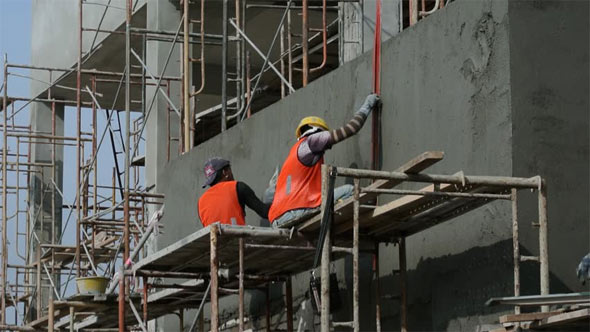Various types of plastering for construction work
- Concrete Cost Estimator
- Concrete Continuous Footing
- Landscape Bidding and Estimating
- Construction Cost Estimating
- Concrete and steel cost estimation
- Construction Cost Estimate Breakdown
- Construction Estimating Worksheet
- Home Construction Cost Estimate
- Estimate Pricing Sheet
- Sheet for General Contractor
- Construction Cost Estimate
- Labor Materials Cost Estimator
- Masonry Estimating Sheet
- Sheet for Building Contractor
- Construction Schedule Bar chart
- General Cost Estimator Sheet
- General Construction Estimate
- Building and Road Estimating Sheet
- Detailed expense estimates
- Door and Window Takeoff Sheet
- General Construction Cost Estimating Sheet

Given below, the details of various types of plastering mostly found in construction work.
1. Sand faced plaster:
• The first coat of sand faced cement plaster is provided with cement mortar in 1:4 with coarse sand once curing of plaster is finished and kept for seven days, the second coat of cement plaster 1:3 ratio is provided on the first coat.
• Sponge is applied in the second coat if the second coat is drench. The purpose of it is that the density of sand grain is visible on surface remain equal and consistent.
• The surface is retained well watered minimum for 15 days.
2. Rough Cast Plaster:
• This plaster is formed by amalgamating sand and gravel in certain ratio that is dashed over a newly plastered surface.
• The plaster base comprises of two coats i.e. under layer 12 mm thick and top layer 10 mm thick with the cement mortar ratio 1:3.
• To facilitate creating the base more plastic, about 10% of hydrated lime by volume of cement should be included at the time of forming mortar.
3. Pebbled dash plaster:
• It is equivalent to rough cast finish excluding clean pebble of size from 6 mm to 12.5 mm that are dashed against the surface in order that they are laid in position by mortar already used.
4. Smooth cast plaster or plain face plaster:
• This finish is equivalent to sand faced finish apart from fine grained sand that is utilized in place of coarse sand.
• No sponging is provided to uncover the sand grain.
• It is generally provided on internal walls.
5. De peter Plaster:
• This is just another type of rough cast finish.
• The rendering coat of 12 mm thick is provided as in case of pebbled dash finish.
• Since this coat is wet, pieces of gravel are pressed manually on the surface.
• In this way beautiful patterns and ornamental designs are created on the surface by choosing materials with different colors.
6. Washed stone Grit Plaster:
• This plaster is provided in two layers, under layer 12 mm cement plaster in 1: 4 ratio.
• It is channeling the under layer with scratching tools by using cement slurry on the under layer at the rate 2 Kg cement per SQM and on the top layer 1d5 mm cement plaster 1:0.5: 2 ( 1 cement : 0.5 coarse sand : 2 stone chipping 10 MM nominal size. ) in panels with groove all around based on the sanctioned pattern along with washing the top layer with brushes and water to uncover the stone chipping.
7. Plastering with terrazzo finish:
• This plastering is usually 18 mm with Terrazzo finish, rubbed and polished under layer 12mm thick plaster 1:3 and top of 6 mm thick white, black, chocolate l, gray , yellow or green marble chips of 3 mm arranged in cement marble powder mix 3:1 by weight in proportion 4:7 marble powder mix cement 4 : 7 marble chips.
8. External wall cladding by stone:
• This plastering is generally provided with Dholpur stone.

- Application of concrete calculator
- Roofing Calculator can streamline the roof estimating process
- House construction cost calculator
- Engineering column design excel spreadsheet
- Material Estimating Sheet with Excel
- Materials List and Cost Estimate Worksheet
- Concrete Slab Estimating Calculator Sheet
- Common types of foundations for buildings
- Online calculation of construction materials
- Estimating with Excel for the Small Contractor
- Concrete Beam Design Spreadsheet
- Virtual Construction Management app for construction
- Autodesk’s Project Skyscraper
- Reed Construction’s Reed Insight
- Manage your construction project documentation
- Costimator, the popular cost estimating software
- On Center Software for construction professionals
- Free Construction Estimating Software
- Plumbing Calc Pro
- Cost Estimate Worksheet
- HVAC Piping Quantity Takeoff Worksheet
- Construction Estimating Software Sheet
- Estimate Cost Templates
- Construction Punch List
- Construction cost estimating template consisting estimating basic
- Gantt Chart Template for Excel
- Download Civil Engineering Spreadsheets with Verification
- The Building Advisor Estimating and Budgeting Worksheet
- Spreadsheet for design of concrete bridge
- Construction Estimating Software Free








